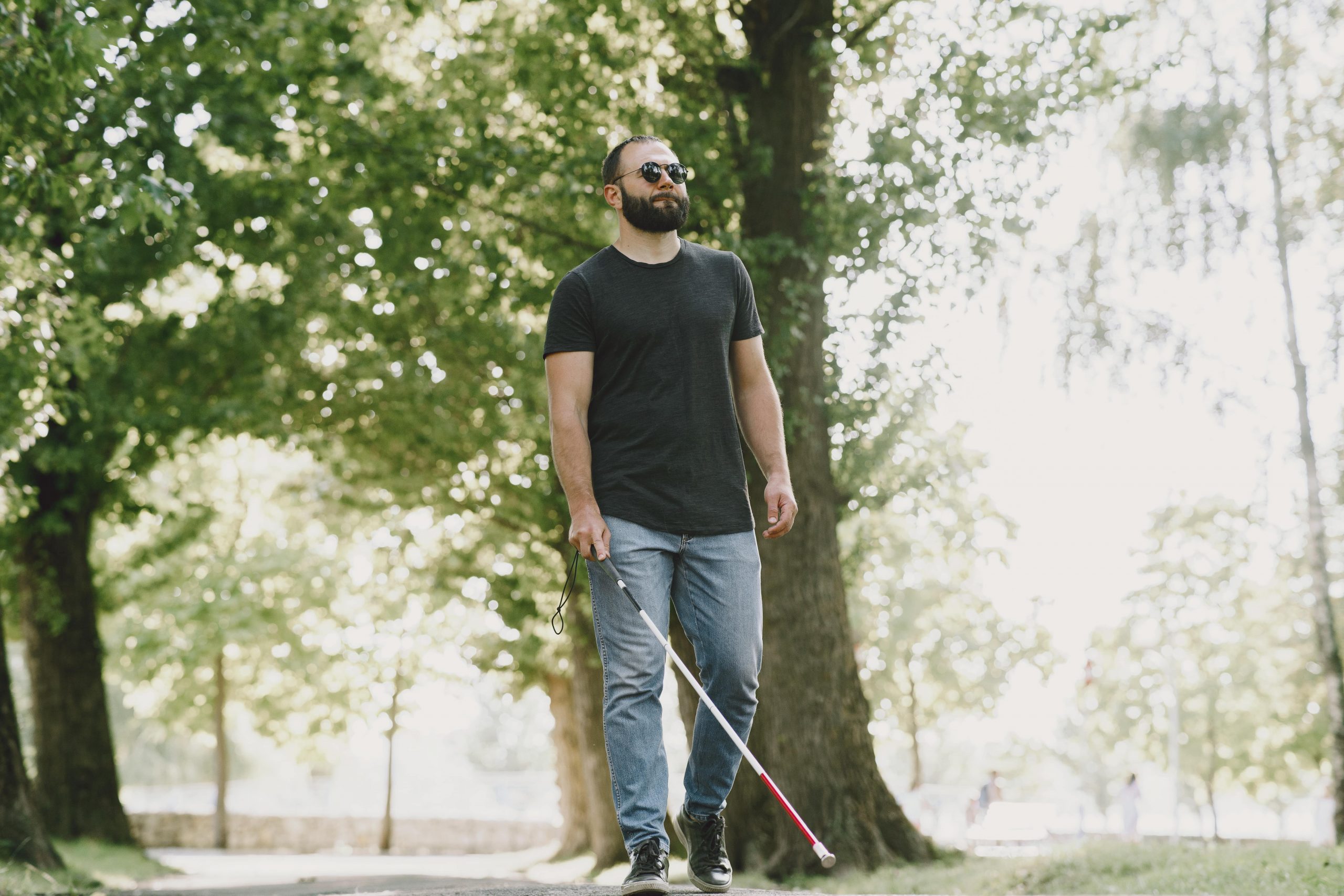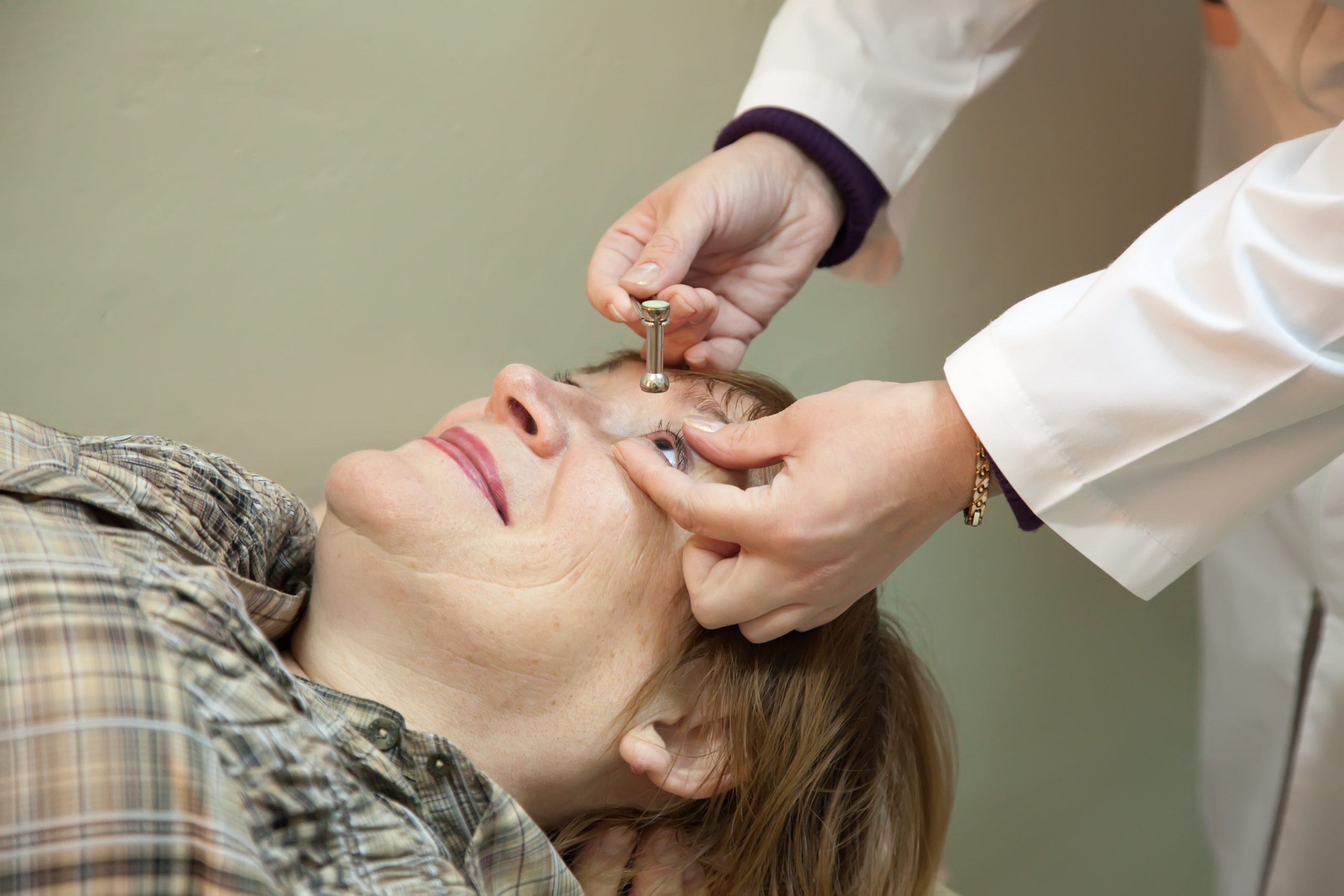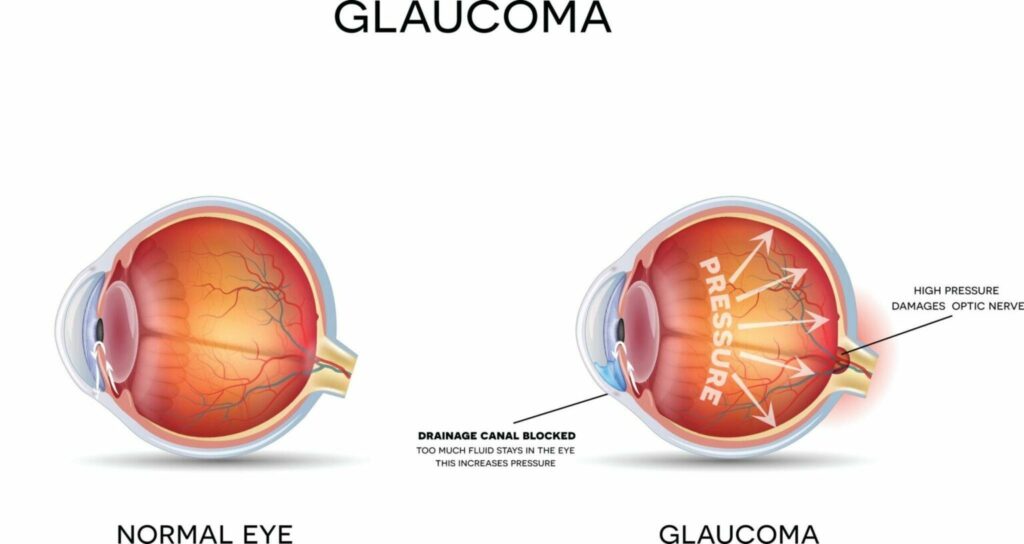Summary
| TYPE of Glaucoma |
Timeline |
| Primary open-angle glaucoma | Slow and overtime |
| Angle-closure glaucoma | Sudden with few early warnings |
| Normal tension glaucoma | Worsens slowly |
| Pigmentary glaucoma | Overtime can cause blindness |
What is Glaucoma?
Your eye is always full of aqueous humor. The same amount of aqueous should drain out as new aqueous enters into your eye. The fluid drains out through a section known as the drainage angle. This procedure maintains a constant intraocular pressure (IOP) in the eye. Fluid builds up if the drainage angle isn’t working properly. The optic nerve is damaged as the pressure inside the eye rises.
More than a million microscopic nerve fibers make up the optic nerve. It’s similar to an electric cable, which is made up of numerous little wires. You will get blind spots in your vision when these nerve fibers perish. These blind spots may not be noticed until the majority of your optic nerve fibers have gone. If all of the fibers die, you will become blind.
Why should you care when your diagnosed with Glaucoma?
The signs and symptoms of glaucoma differ based on the type of glaucoma you have. If you observe any glaucoma symptoms, you should get medical help right away. Regular eye exams are particularly necessary because open-angle glaucoma normally does not cause symptoms until damage has already happened.
Open-angle glaucoma symptoms include:
Symptoms of open-angle glaucoma do not appear until you have already lost some vision. The loss of vision usually begins at the edges of your visual field, resulting in tunnel vision, and proceeds to the center.
Angle-closure or acute glaucoma can cause a variety of symptoms.
The onset of symptoms in angle-closure glaucoma is usually abrupt. Any of these symptoms can become life-threatening at times:
- Headache accompanied by eye symptoms
- Abdominal discomfort (activation of the vagus nerve)
- Eye pain
- Halos around lights
- Nausea with or without vomiting
- Red, irritated eyes (bloodshot eyes)
Congenital glaucoma has a variety of symptoms, those include:
Congenital glaucoma is present at birth, although symptoms do not appear for several months. Among the signs and symptoms are:
- Increased sensitivity to light
- Red, painful eyes (bloodshot eyes)
- Swelling of one or both eyes
Secondary glaucoma symptoms include:
Depending on the source, secondary glaucoma symptoms might be similar to either open-angle or angle-closure glaucoma. Certain drugs, medical procedures, and other medical problems might cause secondary glaucoma.
Symptoms that might signal a severe illness:
Acute angle-closure glaucoma is a severe disease that should be examined in an emergency room as soon as possible. If you or someone you’re with has any of these dangerous symptoms, get medical help right away (call for emergency help).
- Blurred vision
- Eye discomfort
- Halos surrounding lights
- Headache
- Loss of eyesight or changes in vision
What is the time taken to go blind for different types of Glaucoma?
Early detection and treatment typically result in a high level of success and the preservation of eyesight. Glaucoma therapy tries to halt the course of the disease and keep it from impairing your quality of life. Medication, surgery, or laser surgery are all options for treatment. Glaucoma may typically be controlled with eye drops or medications alone, but it cannot be cured. Some medications work by reducing the flow of fluid into the eye, while others work by improving fluid outflow. Laser surgery and surgery to assist fluid escape from the eye are now commonly utilized for the same goal.

Types of glaucoma and how quickly they cause blindness:
Glaucoma with a primary open angle
Damage to the retinal cells develops slowly in primary open-angle glaucoma, the most common kind of glaucoma. Glaucoma can lead to blindness if left untreated for several years. Angle-closure glaucoma (also called “closed-angle glaucoma” or “narrow-angle glaucoma”) Rarer forms of glaucoma can also progress more rapidly, such as angle-closure glaucoma.
Angle-closure glaucoma
Also known as closed-angle glaucoma, is caused by the iris bulging forward, narrowing or blocking the drainage angle created by the cornea and iris. Fluid can’t circulate through the eye as a result, and pressure rises. Angle-closure glaucoma is a condition that affects patients who have small drainage angles.
Angle-closure glaucoma can develop quickly (acute angle-closure glaucoma) or over time (progressive angle-closure glaucoma) (chronic angle-closure glaucoma). Acute angle-closure glaucoma is a life-threatening condition that requires immediate medical attention.
Normal tension glaucoma
The loss of peripheral, or side, vision is frequently the first symptom of normal-tension glaucoma if left untreated. It’s possible that you’ll start missing objects out of the corner of your eye.
Your eyesight narrows as the disease worsens. It’s as though you’re staring down a rabbit hole. You will go blind if all of the fibers in your optic nerve perish.

Normal-tension glaucoma is a slow-progressing condition. It’s critical to schedule frequent eye checkups with an eye doctor. The tests may be able to detect the illness before you lose your vision.
Pigment dispersion syndrome and pigmentary glaucoma
Pigment dispersion syndrome can result in drain damage that is irreversible, as well as increased eye strain. Pigmentary glaucoma develops when the optic nerve is damaged by high eye pressure over time. Glaucoma, if left untreated, can cause visual loss and possibly blindness.
Factors affecting how fast to go blind from Glaucoma?
Open-angle glaucoma is the most prevalent kind of glaucoma, which develops slowly and has minimal early physical signs. Angle-closure glaucoma is a less common kind of glaucoma that can develop quickly.

A medical emergency is an acute angle-closure glaucoma episode. If left untreated, it can soon lead to vision loss and blindness. The following are some of the signs and symptoms:
- Nausea and vomiting
- Headache
- Eye discomfort
- Redness of the eyes
- Blurred vision
- Halos or rainbows surrounding lights
- Blurred vision
If you have an acute angle-closure glaucoma episode, get medical help right away.
How can you slow down vision loss from Glaucoma?
Treatment has the greatest impact on the timing of glaucoma-related visual loss. You can reduce or even stop vision loss if you have frequent eye exams, receive therapy early on, and stick to your treatment plan. In this situation, the risk of blindness is considerably reduced.
Can Glaucoma be cured or slowed down significantly?
It is impossible to restore visual loss caused by optic nerve injury and glaucoma once it has occurred. Treatment can, however, delay the progression of visual loss.
There are several things you can take to help prevent glaucoma and glaucoma-related visual loss.
Exercise on a regular basis to maintain healthy blood flow, and eat a well-balanced and nutritious diet to maintain good physical health.
- Have frequent eye examinations with dilated pupils and IOP measurements.
- Take any prescription drugs exactly as instructed by your doctor, and follow his or her treatment recommendations to the letter.
- Visit a low vision expert and obtain the correct treatment.
- Wear eye protection to keep your eyes protected from harm and trauma.
The majority of the time, glaucoma does not result in blindness if it is managed. You may frequently avoid or slow significant vision loss if you take care of your eyes and treat the disease appropriately.
What is the speed at which different age groups of people go blind with Glaucoma?
There are certain risk factors that might raise your chances of developing the disease.
- Age: Glaucoma is more frequent in those over the age of 60 in the United States.
- Race: It is more prevalent in African Americans, Asians, and Hispanics over the age of 40.
- Family history: Glaucoma is a hereditary disease.
- Medical/biological conditions: Some medical problems, such as diabetes and high blood pressure, make glaucoma more likely. The risk is further increased by thin corneas and persistent eye irritation.
- Trauma: An eye injury might cause increased ocular pressure.
- Medications: Long-term use of corticosteroids raises the risk of developing glaucoma.
What geographical conditions are good to slow down the degeneration with Glaucoma?
Did you realize that being outside in the cold might aggravate your glaucoma? Glaucoma is worse in the cold, according to research conducted by the Devers Eye Institute in Portland, Oregon. This is especially true for those who are in the early stages of the illness. The more severe the weather, the more it affects glaucoma.
Because of the changing weather in New York throughout the winter, you may notice that your symptoms are worse at this time of year. Let’s look at why cold weather affects glaucoma and what you may do to prevent more damage.
Why Cold Weather Impacts Glaucoma

The winter weather in Chicago, Minnesota, Massachusetts, New York City, etc., is unpredictable. It can be bright and 50 degrees one day and snowing and 20 degrees the next. This sudden shift in temperature might induce pressure changes in the body, which can affect the eyes directly.
Glaucoma patients have excessive eye pressure. Too much pressure in the eyes stresses the optic nerve, resulting in visual issues like blindness, blind spots, and vision loss. When the weather in the northeast is severe, as it often is in the winter, ocular pressure can rise above average.












